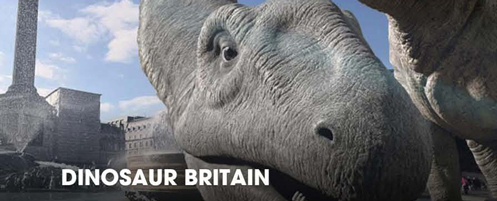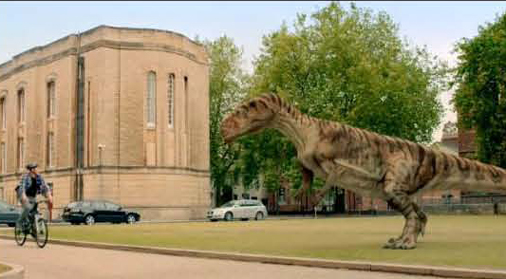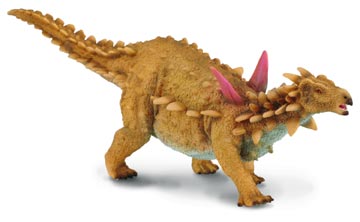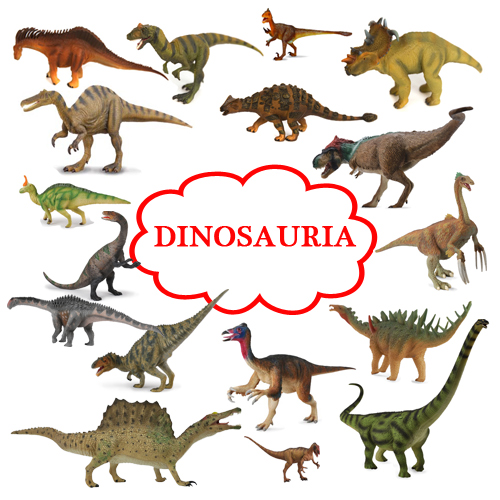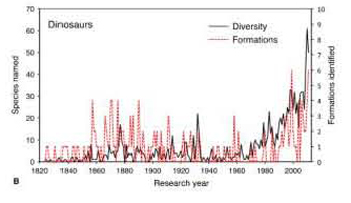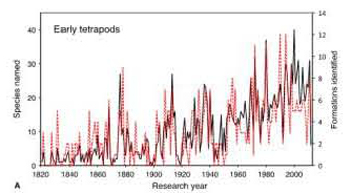A Special Dinosaur Britain Programme – Part 1
Dinosaur Britain – Part 1 – Quick Review
The Oxford University Museum of Natural History might not be the same again after one of its most famous items in the collection, the Megalosaurus bucklandii came to life and pursued a cyclist down the high street. Just one of the scenarios acted out tonight in the very informative “Dinosaur Britain” which was aired on ITV1 this evening. This was the first part in a two-part documentary made by Maverick TV which sets out to explore the rich dinosaur heritage of the British Isles.
Dinosaur Britain – Bank Holiday Family Entertainment
Picture credit: Maverick TV
Aimed very much at a family audience, the first programme sees presenter Ellie Harrison going on a tour of the United Kingdom to learn about some of the amazing dinosaurs that once roamed this part of the world. Even today, we at Everything Dinosaur estimate that, one in twenty of all the dinosaurs known to science is represented by fossils found in the British Isles, that’s about one hundred different species and what an eclectic bunch they are.
Dinosaur Britain
Ellie is guided on her tour of Britain’s dinosaurs by our chum Dean Lomax, a palaeontologist who has recently written an excellent book entitled “Dinosaurs of the British Isles”, so he is ably qualified to assist Ms Harrison on her quest to learn about these amazing reptiles.
For further information on “Dinosaurs of the British Isles”: Siri Scientific Press.
After a close encounter with Baryonyx in the Natural History Museum, Ellie meets up with a Megalosaurus, which does look a little out of place scavenging a council bin for a quick snack. After all, Oxfordshire has changed quite a bit in the 167 million years ago since Megalosaurus was around.
Megalosaurus on the Prowl
Picture credit: Maverick TV
Crystal Palace Dinosaurs
Then it’s to South London to view the Crystal Palace dinosaur sculptures and to hand feed an Iguanodon, the CGI permitting viewers to see for themselves how our interpretations of the Dinosauria have changed since the time of the Great Exhibition. Britain’s own “raptor” Nuthetes destructor, the name means “destroyer monitor”, makes an appearance, strangely enough at Stonehenge, although the fossils were found on the Isle of Purbeck (Dorset), cue more running for Dean and Ellie. Good to see feathers on our turkey-sized dromaeosaurids.
Perhaps, for us the best part of the programme concerned the Early Jurassic armoured dinosaur Scelidosaurus. The fossil specimen, part of the Bristol Museum and Art Gallery collection is truly remarkable and who better to talk to about it than David Sole, the Dorset fossil collector who discovered the fossils back in 2000. Professor Mike Benton is our guide at the Bristol Museum, he explains how this beautiful dinosaur fossil came to be preserved in such an amazing articulated state.
Scelidosaurus Model
Claim to fame for Everything Dinosaur, we supply the Scelidosaurus models for the Museum’s shop.
Scelidosaurus Model
Picture credit: Everything Dinosaur
To read more about Scelidosaurus: Britain’s Most Complete Dinosaur Fossil Discovered to Date.
A Dedicated Television Series “Dinosaur Britain”
The programme blended dinosaur facts and entertainment quite well in our opinion. The focus for part one was very much on English dinosaurs, expect other parts of the British Isles to get more of a look in with the second programme which is scheduled to be shown tomorrow at 8pm.
Our congratulations to the programme makers, it is good to see that “British dinosaurs” are getting a share of the limelight.
The Scelidosaurus model shown is part of the CollectA Deluxe model range: CollectA Deluxe Prehistoric World Models.


